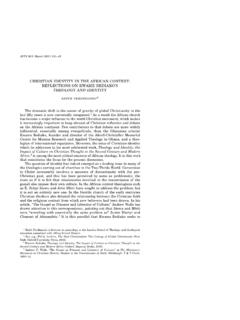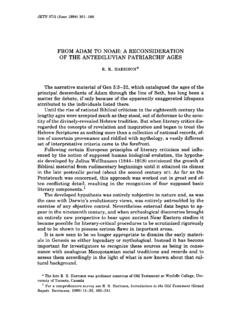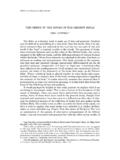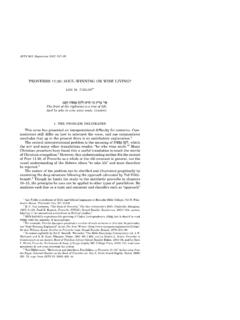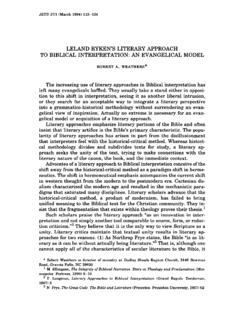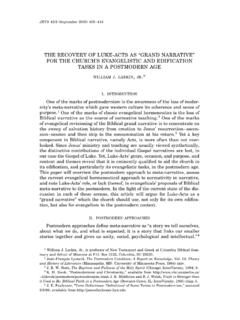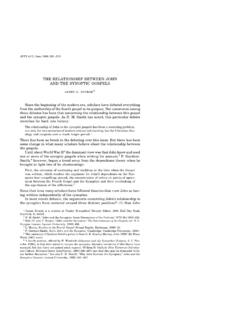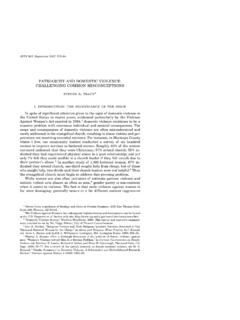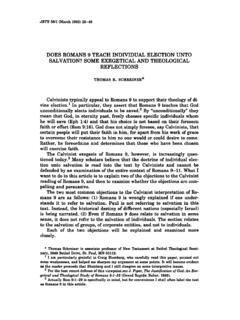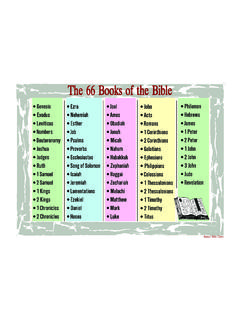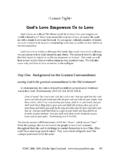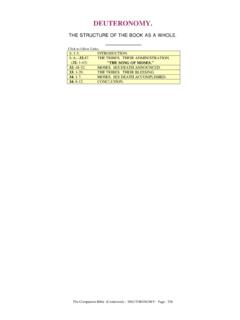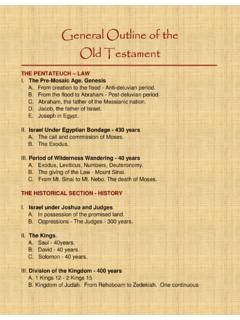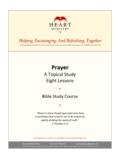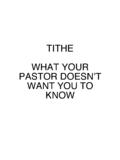Transcription of HOW MANY IS GOD? AN INVESTIGATION INTO …
1 JETS 47/2 (June 2004) 193 212 HOW MANY IS GOD?AN INVESTIGATION into THEMEANING OF deuteronomy 6:4 5 1 daniel i. block*i. introduction In deuteronomy 6:4 Moses commences the second major section of hissecond address. The limits of this segment are marked by his call, Listen,O Israel! at the beginning, and the warning of Israel s certain doom at theend, because you would not listen to the voice of Yahweh your God (8:20).This demarcation is confirmed by 9:1, which signals the beginning of a newsubsection with a third call to Hear! (cf. 5:1). Between these two markers,Moses offers a profound exposition of the essence of Israel s covenant rela-tionship with Yahweh. Moses announces the grand theme of this section inemphatic but eloquent style with the Shema in 6:4 5: a call for exclusivecovenant commitment to maintains his covenantal focus throughout this section particularlythrough the repetition of the phrase Yahweh your God, which occurs 31times, and Yahweh our God, which occurs an additional four times, yield-ing a total of 35 occurrences in 68 verses.
2 The covenant mediator describesthis relationship from both sides. On the one hand, he notes Yahweh s lovefor Israel (7:7, 8, 13), his faithfulness to his covenant (6:10, 18, 23; 7:8, 9, 12;8:18), and his providential care for them (8:2 16). On the other hand, heemphasizes the response that Yahweh expects from his people: love (6:5);fear (6:13, 24; 8:6); trust (7:17 24); and remembrance (6:12; 8:11, 18, 19); tosay nothing of obedience, which is a constant 6:4 9 represents the thematic introduction to this ex-tended segment of Moses second address. This paragraph is probably morefamiliar to us than any other part of deuteronomy . The niv translates it asfollows: 4 Hear, O Israel: The LORD our God, the LORD is one. 5 Love the LORD yourGod with all your heart and with all your soul and with all your strength. 6 These commandments that I give you today are to be upon your hearts.
3 7 Impress them on your children. Talk about them when you sit at home andwhen you walk along the road, when you lie down and when you get up. 8 Tie 1 This is an expanded version of the paper read to the Evangelical Theological Society in At-lanta, November, 2003. * Daniel Block is professor of Old Testament at the Southern Baptist Theological Seminary,2825 Lexington Road, Louisville, KY 40280. journal of the evangelical theological society 194 them as symbols on your hands and bind them on your foreheads. 9 Write themon the doorframes of your houses and on your gates. This first subsection of 6:4 8:20 may be the shortest, but it is the mosteloquent, and in many ways the most profound. Readers tend to fix theirattention on the opening Hear, O Israel, but we need to realize that this s ma is just the first of a series of six imperatives that dominate the para-graph consisting of verses 4 9: Hear, Love, Impress, Speak, Bind, and Write.
4 The two exceptions to this pattern (vv. 6, 8b) are cast in thethird person, with inanimate objects as their subject. However, since thewords cannot find their place upon your hearts (v. 6), nor appear as phy-lacteries between your eyes, by themselves (v. 8b), even these statementshave imperatival challenge in Deut 6:4 is known as the Shema , a designation thatderives from the first word in Hebrew. 2 The Shema represents one of themost important symbols of Judaism. In most Hebrew manuscripts the last let-ters of the first and last words are exceptionally large, presumably to warn thereader that at this point the reading is to be especially precise. 3 The lxx pref-aces the Shema with a long introduction, apparently an adaptation of 4:45: 4 ka tau ta ta; dikai mata ka ta; kr mata o sa ejnete lato kuvrio to u o Israhl ejnt ejrhvm ejxelqovntwn au t n ejk gh A guvptou.
5 And these are the judgments that the LORD commanded the sons of Israel inthe desert when they went out of the land of Egypt.. The catechetical/liturgical significance of the Shema in ancient Judaismis reflected by the fact that it appears immediately after the Decalogue inthe Nash Papyrus, a second-century bc liturgical text, 5 and in a first-century ad phylactery text from Cave 8 at Qumran, where the Shema is written ina rectangle and surrounded by other texts. 6 To this day, orthodox Jews re- 2 Although this paper is concerned primarily with verse 4, verse 5 is often treated as part ofthe Shema . This is taken for granted in Paul Foster s most recent discussion of the forms and useof the Shema in the Gospels in Why did Matthew get the Shema wrong? A Study of Matthew22:37, JBL 133 (2003) 309 33. 3 Thus I. Yeivin, Introduction to the Tiberian Masorah (trans. and ed.)
6 E. J. Revell; MasoreticStudies 5; Missoula: Scholars Press, 1980) 48. To read the final daledh as a resh (the two letterswere often confused) would create a blasphemous a ar , another, other. Alternatively the com-bination of the two last letters, ayin and daledh spells e d , witness, suggesting either that theShema is a witness to the unity of Yahweh (Jeffrey Tigay, deuteronomy [NJPS Torah Commen-tary; Philadelphia: Jewish Publication Society, 1996] 441), or that the Shema is a witness againstIsrael, in which case it functions like the Song of Moses in 31:19 21. Cf. Ps 50:7, Hear, O my peo-ple, and I will speak; O Israel I will testify against you; I am God your God. 4 So also John William Wevers, Notes on the Greek Text of deuteronomy (SBLSCS 39; Atlanta:Scholars Press, 1995) 114. 5 The papyrus includes a Hebrew version of the long introduction found in the lxx.
7 See Eman-uel Tov, Textual Criticism of the Hebrew Bible (2d rev. ed.; Minneapolis: Fortress, 1992) 118;Ernst W rthwein, The Text of the Old Testament, trans. E. F. Rhodes; 2d ed.; Grand Rapids:Eerdmans, 1995) 34, 144 45. For a discussion of the nature and liturgical significance of theShema in the Nash Papyrus see Foster, Why did Matthew get the Shema Wrong? 327 28. 6 8 QPhyl; published by M. Baillet, Les Petites Grottes de Qumr n. Exploration de la falaise. Lesgrottes 2Q, 3Q, 5Q, 6Q, 7Q 10Q (Discoveries in the Judaean Desert 3; Oxford: Clarendon, 1962) how many is god ? 195cite the Shema twice daily as part of their prayers in the morning whenthey wake up, and at night before they fall asleep (cf. the instruction in v. 7). 7 In so doing they take the yoke of the kingdom, which is to say that theyplace themselves under the sovereignty and kingship of Yahweh. 8 The Shema is as close as early Judaism came to the formulation of a importance of the Shema in Jewish tradition is also reflected in theGospels.
8 One day, apparently seeking to change the subject away from theissue of the resurrection, over which the Pharisees and Sadducees were ar-guing, one of the scribes asked Jesus, Which commandment is the most im-portant of all? To which Jesus replied, The most important is, Hear, O Israel: The Lord our God, the Lord is one. Andyou shall love the Lord your God with all your heart and with all your soul andwith all your mind and with all your strength. The second is this: You shalllove your neighbor as yourself. There is no other commandment greater thanthese. (Mark 12:29 31 esv ) 9 ii. the problem of the shema Despite the importance of the Shema in Jewish and Christian tradition,it is in fact quite enigmatic, and has fueled scholarly discussion out of allproportion to these six small words. 10 The style and meaning of the first twowords are clear a vocative addressing Israel (cf.)
9 4:1; 5:1; 9:1; 27:9) 11 and 7 The tradition goes back a long time. See Josephus, Antiquities , 13; m. Ber. 1,2,3. Theremay also be an allusion to the practice in 1QS 10:10, At the onset of day and night I shall enterthe covenant of God, and when evening and morning depart I shall repeat his precepts; and bytheir existence I shall set my limit without turning away (as translated by Florentino G. Mart nezand Eibert J. C. Tigchelaar, The Dead Sea Scrolls Study Edition [Leiden/New York: Brill, 1997] ). For discussion see A. R. C. Leaney, The Rule of Qumran and its meaning (NTL; London:SCM, 1966) 239 41, 245. 8 According to the Talmud ( Ber. 15b), Gehenna is cooled for whoever pronounces the Shemacorrectly. For discussions of the Shema in early Judaism see L. Jacobs. Shema, Reading of, in Encyclopeaedia Judaica (New York: Macmillan, 1971) 74; S. D. McBride, The Yoke of theKingdom: An Exposition of Deut.
10 6:4 5, Int 27 (1973) 273 306, esp. 275 79; F. E. Vokes, Creedsin the New Testament, SE 6 (1973) 582 84. 9 Neither Matthew (22:37 40) nor Luke (10:26 27) includes the first clause of the Shema inthe citation. For analysis of the Synoptic issues, especially the variations in the forms of the callfor unreserved love for God, see Foster, Why did Matthew get the Shema Wrong? 309 33. 10 See most recently L. J. Bord and D. Hamidovic ! , coute Isra l (Deut. VI 4), VT 52 (2002)13 29. 11 A rabbinic tradition reflected in Sifre deuteronomy 31 and Targum Pseudo-Jonathan under-stands Israel as an individual appellation, that is, the patriarch Jacob. This is evident in thelatter s very expansive reading of verses 4 5:And it was, w hen the time was reached for our father Jacob to be gathered from the midstof the world, he was afraid lest there be a defect among his sons. He called them and askedthem: is there any guile in your hearts?
